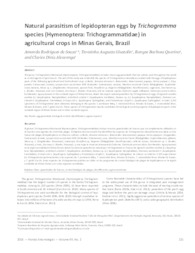Natural parasitism of lepidopteran eggs by Trichogramma species (Hymenoptera: Trichogrammatidae) in agricultural crops in Minas Gerais, Brazil.
Natural parasitism of lepidopteran eggs by Trichogramma species (Hymenoptera: Trichogrammatidae) in agricultural crops in Minas Gerais, Brazil.
Autoria: SOUZA, A. R. de; GIUSTOLIN, T. A.; QUERINO, R. B.; ALVARENGA, C. D.
Resumo: The genus Trichogramma Westwood (Hymenoptera: Trichogrammatidae) includes insect egg parasitoids that are widely used throughout the world as control agents of pest insects. The aim of this study was to identify the species of Trichogramma naturally associated with the eggs of lepidopteran pests of the following agricultural and horticultural crops: collards, Brassica oleracea L. (Brassicales: Brassicaceae); papaya, Carica papaya L. (Capparales: Caricaceae); tomato, Lycopersicon esculentum Mill. (Solanales: Solanaceae); cassava, Manihot esculenta Crantz (Malpighiales: Euphorbiaceae); banana, Musa sp. L. (Zingiberales: Musaceae); passion fruit, Passiflora sp. Degener (Malpighiales: Passifloraceae); sugarcane, Saccharum sp. L. (Poales: Poaceae); and corn (maize), Zea mays L. (Poales: Poaceae); and an invasive species (Sodom?s apple milkweed, Calotropis procera Aiton; Gentianales: Apocynaceae) in the semiarid region of Minas Gerais, Brazil. We report natural parasitism by Trichogramma in eggs of Agraulis vanillae vanillae (L.) (Lepidoptera: Nymphalidae), Antichloris eriphia F. (Lepidoptera: Arctiidae), Danaus sp. (L.) (Lepidoptera: Nymphalidae), Diatraea saccharalis F. (Lepidoptera: Crambidae), Erinnyis ello L. (Lepidopera: Sphingidae), and Protambulyx strigilis L. (Lepidopera: Sphingidae). In total, 2,242 specimens of Trichogramma were obtained, belonging to the species T. pretiosum Riley, T. manicobai Brun, Moraes & Soares, T. marandobai Brun, Moraes & Soares, and T. galloi Zucchi. These species of Trichogramma may be candidates for biological control programs of lepidopteran pests in the semiarid region of Minas Gerais and in other semiarid regions.
Ano de publicação: 2016
Tipo de publicação: Artigo de periódico
Unidade: Embrapa Meio-Norte
Palavras-chave: Agroecossistemas, Controle biológico de pragas, Identificação, Parasitóides de ovos
Observações
1 - Por padrão são exibidas publicações dos últimos 20 anos. Para encontrar publicações mais antigas, configure o filtro ano de publicação, colocando o ano a partir do qual você deseja encontrar publicações. O filtro está na coluna da esquerda na busca acima.
2 - Para ler algumas publicações da Embrapa (apenas as que estão em formato ePub), é necessário ter, no celular ou computador, um desses softwares gratuitos. Sistemas Android: Google Play Livros; IOS: iBooks; Windows e Linux: software Calibre.
Acesse outras publicações
Acesse a Base de Dados da Pesquisa Agropecuária (BDPA) para consultar o acervo completo das bibliotecas da Embrapa.

